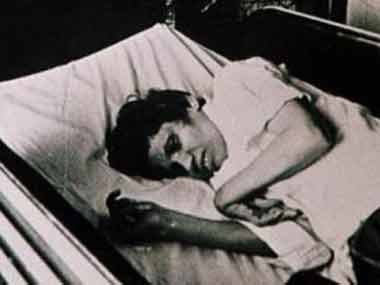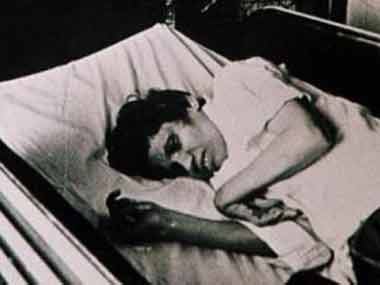The death of former nurse Aruna Shanbaug in Mumbai’s KEM hospital this morning (18 May) is probably the best thing that’s happened to her in 42 years. She has been brain-dead and in a vegetative state since the night of 27 November 1973, when she was brutally and sexually assaulted by a ward-boy who also choked her with a dog-chain. This cut off blood supply to the brain, resulting in brain stem contusion and injury to her cervical cord, which also left her cortically blind. She was artificially kept alive by nurses at Mumbai’s KEM Hospital even though Shanbaug herself would have been unaware of life as we know it. Her death brings an end to agony that she may not have been aware of, but it poses uncomfortable questions to us as a society. Among them: [caption id=“attachment_2249826” align=“alignleft” width=“380”]  Ibnlive image[/caption] #1: How is it fair to allow a human being to live a vegetative state for so long? Human beings have a right to life, but is this life? Surely, a year in coma with sustained medical intervention can be a good enough cutoff point after which euthanasia should be considered by people with no vested interest in the patient’s passing? #2: How is it conscionable for a society that does not provide adequate hospital care for so many people, including hospices for the old and senile, to block resources for someone who had no chance of recovery even to the stage of bed-ridden consciousness? #3: Is passive euthanasia enough? Who, and how, must society decide on pulling the plug on cases like Shanbaug. When Shanbaug’s case went upto the Supreme Court, the court did not sanction active euthanasia, but okayed passive euthanasia – which means withdrawing treatment and not offering regular food that she cannot consume on her own. The court verdict came in March 29011, and the fact that Shanbaug lived for four more years means she lived due to the consistent care given to her by KEM nurses. Clearly, passive euthanasia is no solution in some cases. Beyond satisfying the care-giving instincts of the nurses, who obviously had love and emotional bonding with a sister-nurse who was the victim of rape, the Supreme Court decision actually achieved nothing. It is time to tackle the question more boldly. The real issue is the right to die with dignity – which has two broad angles. One involves persons who can’t decide for themselves (cases like Shanbaug, or minors or old people with dementia who may be in extreme pain by can’t take a rational decision); the other involves people who are otherwise competent to decide to end their lives for various reasons, especially extreme pain, but are not allowed to do so by the law. As things stand now, only four European countries (Switzerland, Belgium, Netherlands and Luxembourg) allow for assisted suicide, where patients are given lethal doses of killer drugs when they are in terrible pain, and have illnesses that can’t be cured, and they make a decision to die consciously without prompting by people who may gain from their deaths. (Read this Guardian story on euthanasia and assisted suicide laws around the world). Euthanasia is controversial for many reasons: The most important reason is often religious. Most religions oppose the idea because they see it as going against god’s will. But religion is never rational on this score. Since god’s will can never be known, it makes no sense to pander to his presumed will. It is human reasoning that must prevail. The second reason is that neither family nor doctors feel comfortable playing god themselves. This is a real issue. The state clearly has to set foolproof guidelines on who can take these decisions, and create panels that can supervise passive or active euthanasia. The third reason is the expectation that some time, at some point, science may discover something that could be of help. Now, this reason appears valid, but surely some kind of cut-off is needed? Maybe, sometime in 2020, somebody could have found a way to revive Aruna Shanbaug. But this is a case for not letting anybody die. Some sensible cut-off time limit, based on knowledge of current medical knowledge and likely future developments, can be crucial in these decisions. The last reason is, of course legal: what if someone will gain from the death of a terminally ill patient? This is the easiest objection to get over with. All it needs the creation of guidelines on who will take this call, and who will review whether the call to assist euthanasia is a valid one or not. There is, of course, one more reason, and it seems crass and unfeeling: the economic reason. A bed occupied nearly permanently by a brain-dead or comatose patient is a bed denied to someone whose life could have been saved by it. Society cannot avoid the question of whose life is more valuable when the choice is not between two lives, but between one who is oblivious to conscious life and another who isn’t. The answer should be clear. The time for more waffle on assisted suicide is over. We need a proper law on euthanasia with strong safeguards. The Right to Die with Dignity is an inalienable part of the Right to Life.
The case of Aruna Shanbaug, who died today after 42 years in a brain-dead condition, strengthens the case for a sensible law on passive and assisted suicide. India should not dodge the issue any more
Advertisement
End of Article
Written by R Jagannathan
R Jagannathan is the Editor-in-Chief of Firstpost. see more


)
)
)
)
)
)
)
)
)



